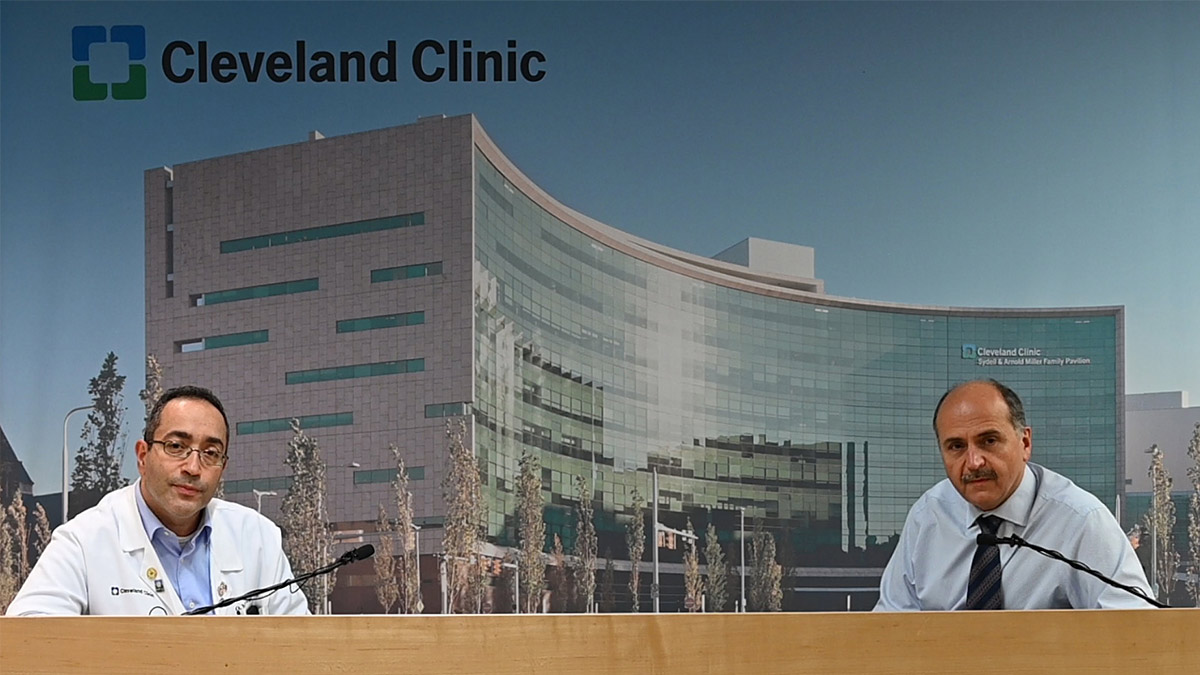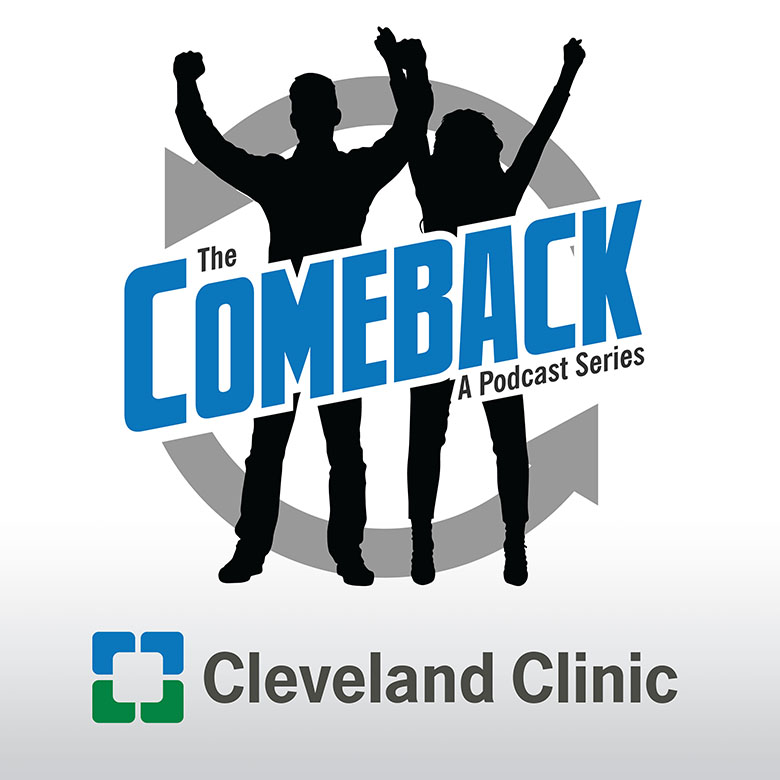Oral Anticoagulation vs. Watchman in Non-Valvular Atrial Fibrillation

Patients often ask why they need to be on an anticoagulant after ablation – or – if they can have a Watchman device at the same time as an ablation. Drs. Saliba and Wazni discuss the answers to these questions. The OPTION trial is looking at the safety and effectiveness of the Watchman device (left atrial appendage closure) vs. oral anticoagulant medications in patients with non-valvular atrial fibrillation.
Patients who have had an ablation or who are going to have an ablation will be randomized to WATCHMAN device vs. oral anticoagulation. Patients are followed for three years, looking at outcomes of stroke, mortality, cardiovascular events and risk of bleeding. Interested patients should talk with their doctor or contact the Atrial Fibrillation Stroke Prevention Center.
Subscribe: Apple Podcasts | Podcast Addict | Buzzsprout | Spotify
Oral Anticoagulation vs. Watchman in Non-Valvular Atrial Fibrillation
Podcast Transcript
Announcer:Welcome to Love Your Heart, brought to you by Cleveland Clinic's Sydell and Arnold Miller Family Heart, Vascular and Thoracic Institute. These podcasts will help you learn more about your heart, thoracic and vascular systems, ways to stay healthy, and information about diseases and treatment options. Enjoy.
Dr. Oussama Wazni:
My name is Oussama Wazni. I'm the Section Head of EP here at the Cleveland Clinic, and with me is Dr. Walid Saliba who is the director of the AFib Center and also of the AFib Stroke Prevention Center here at the clinic. Welcome to this podcast. We are going to talk about the OPTION trial. And I start off by asking Dr. Saliba to tell us what is the OPTION trial?
Dr. Walid Saliba:
So the OPTION trial is a trial that addresses one very important question, which is, what to do with patients with nonvalvular atrial fibrillation following an ablation, as far as their anticoagulation status and their stroke prevention strategy. The OPTION trial came from essentially three main issues. Number one, we know that atrial fibrillation ablation is not a cure of atrial fibrillation. Patients who have an ablation will continue probably or at risk of having more atrial fibrillation that is predominantly asymptomatic, and therefore they have ongoing risk of stroke following the ablation procedure.
Dr. Walid Saliba:
Second, we do not know exactly what to do with anticoagulation following an ablation procedure. Because of our previous experience, what we have done is patients who have had an ablation procedure and are at increased risk of stroke, should continue, based on recommendations and guidelines, should continue on taking oral anticoagulation. But here we have now a strategy, which is the WATCHMAN device, left atrial appendage occlusion WATCHMAN device, that has been shown in patients with nonvalvular if to have equal reduction of risk of stroke to oral anticoagulation. So can we take that strategy and apply it to patients who are getting an AFib ablation?
Dr. Walid Saliba:
This is what the OPTION trial is. It's going to take patients who are going to have an AFib ablation, or who've had recent atrial fibrillation ablation, and we're going to randomize them to standard of care, which is they will continue on oral anticoagulation or device therapy, which means that they're going to have a WATCHMAN device, left atrial appendage occlusion WATCHMAN device.
Dr. Walid Saliba:
That WATCHMAN device can be implanted either at the time of the ablation or three to six months following the ablation. So we will have two groups, one group on oral anticoagulation, following ablation, and another group who has had the WATHCMAN implanted following an ablation. And we're going to follow these two groups for a period of three years, looking to see if there is a reduction in risk of a stroke, a reduction in mortality, a reduction in cardiovascular events, and also looking more importantly at the risk of bleeding for the next three years following the randomization.
Dr. Oussama Wazni:
So how many patients are we going to be enrolling?
Dr. Walid Saliba:
So we're planning on enrolling 1600 patients, and this is a multicenter trial, of course. That's going to be 800 in each group. And the breakdown of the number of patients who will have a concomitant AFib ablation and WATCHMAN device versus the patients who will have a sequential approach, which is an ablation followed three to six months by a WATCHMAN device, will be decided based on individual centers.
Dr. Oussama Wazni:
Should we do that ablation and we implant the WATCHMAN. Do we stop the anticoagulation at that point? Or do we have to continue that?
Dr. Walid Saliba:
So the anticoagulation strategy following the WATCHMAN device implant, if it's a sequential, if it's a concomitant procedure, we continue oral anticoagulation for a period of three months, following which we'll stop the anticoagulation if we think that the device is in good place and there are no leaks around it, and these patients will continue indefinitely on aspirin.
Dr. Oussama Wazni:
So another aspect of the OPTION trial, and why I think the OPTION is one of the most important AFib ablation trials, is to answer the question or this concern about, okay, well, we just did an ablation. Why should we continue anti-coagulants indefinitely if, for example, a patient is deemed to have had a successful ablation?
Dr. Walid Saliba:
Well, this is a very interesting and an important question because true enough, if my stroke risk is dependent on atrial fibrillation, then why do I need to continue oral anticoagulation following an ablation and I don't feel any atrial fibrillation? Well, two reasons. Number one, first of all, patients who've had an ablation, chances are that they will continue to have some atrial fibrillation, and some of this atrial fibrillation might be asymptomatic. But I think the most important part of this question relies on the fact that yes, true, atrial fibrillation is a risk for stroke in those patients, but more importantly, atrial fibrillation can be a marker or a manifestation of risk factors that increase your risk of stroke to the same extent that it increases your risk of having atrial fibrillation. So atrial fibrillation and stroke can be essentially two manifestations of the same disease that causes the stroke and causes the atrial fibrillation. And the fact that we got trig the atrial fibrillation does not necessarily mean that the risk of stroke is significantly lower.
Dr. Oussama Wazni:
And that is the other risk of continuing an anticoagulant and exposing the patient to a risk of bleeding when, in fact, they don't have afib anymore.
Dr. Walid Saliba:
That is correct. And this is one thing that the OPTION trial is looking at as one of the endpoints is as on the superiority level that actually the WATCHMAN device will negate the risk of continuous oral anticoagulation and the associated bleeding that comes from it.
Dr. Oussama Wazni:
Yeah. So what the hypothesis is, and I'm leading the study globally, is that the WATCHMAN in this patient population will decrease the risk of ischemic stroke, while at the same time also decreasing the risk of bleeding compared to a population that continues to take anticoagulants indefinitely basically.
Dr. Walid Saliba:
That is correct. And if the study is positive, this definitely will expand the current indications that we have for the WATCHMAN device.
Dr. Oussama Wazni:
So, Dr. Saliba, here at the Clinic, we've had the good fortune that we're able to do. Most of these patients who get randomized to the WATCHMAN arm conglomerate, and you are leading the study here at the clinic. What are the advantages of doing this procedure concomitantly? Meaning in the same setting, the same.
Dr. Walid Saliba:
So think about it this way. You have a procedure which is the atrial fibrillation ablation, and you have another procedure that is the WATCHMAN device closure. You can do them separately on two different days. This means that the patient has to come to the hospital, be subjected to general anesthesia, twice, be subjected to getting access to the left atrium via transseptal approach twice. The hospital is going to charge twice and the risk is going to be essentially duplicated. And if you think about it, when you do an AFib ablation, you're in the left atrium, and when you implant a WATCHMAN device, you're in the left atrium. So since you are in the same zip code in the same neighborhood, and you just did a AFib ablation, you can just put another catheter in there and close the left atrial appendage in the same setting, therefore reducing the risk of having twice the procedure, reducing the risk of twice general anesthesia, and potentially also reducing the cost of the procedure as a whole. So there are all kinds of advantages.
Dr. Walid Saliba:
There are also some potential, I'm not going to call them disadvantages, but concerns that we are trying to solve, is that, well, you did enough an AFib ablation, you created some edema, you created some inflammation. Well, is it possible to put a device and that device is going to be stable in that location? So far, we haven't had a problem. And all the studies that were done all around the world have not shown any potential issues with the combined procedure. And then we are looking forward and very excited about the possibility actually of doing both procedures at the same time because ,frankly speaking, it makes medical sense. Perfect sense.
Dr. Oussama Wazni:
I think it's the better thing for the patient, frankly. Now, also, in the OPTION trial, we're using the new WATCHMAN flex device. Can you tell us something about the new WATCHMAN flex and how it compares to the original WATCHMAN?
Dr. Walid Saliba:
So the new device is actually, in layman's term, much funner to use than the older generation WATCHMAN device. Why is that? Well, number one, the way it's built. It's a sturdier. It has a more, if you want, framework that can fill the os of the left atrial appendage, it has more anchors to give it more stability so that it's less likely to dislodge. More importantly, the distal end of the device is rounded and closed so it doesn't have exposed feet. And therefore, the way you implant it, and the way you navigate in the left atrial appendage is less risky. And the incidents of having, God forbid, a perforation, or what have you, is definitely less.
Dr. Walid Saliba:
And for the implanter, it becomes easier to navigate into the left atrial appendage with the flex device compared to its older cousin, older brother, the regular WATCHMAN device. And from the procedure standpoint, it makes the procedure maybe faster and less of, I would say, less risks and less daunting than the older ones.
Dr. Oussama Wazni:
So less risk for the patient and probably more flexibility for the implanter to place it in the optimal position.
Dr. Walid Saliba:
Well, there are some appendages that we couldn't close with the older generation device because they are either very shallow or very big. Definitely with the newer device, we should be able to attack those without problems.
Dr. Oussama Wazni:
All right. Thank you very much, Dr. Saliba. I think that was an excellent overview of the OPTION trial. Thank you.
Announcer:
Thank you for listening. We hope you enjoyed the podcast. We welcome your comments and feedback. Please contact us at heart@ccf.org. Like what you heard? Subscribe wherever you get your podcasts or listen at clevelandclinic.org/loveyourheartpodcast.

Love Your Heart
A Cleveland Clinic podcast to help you learn more about heart and vascular disease and conditions affecting your chest. We explore prevention, diagnostic tests, medical and surgical treatments, new innovations and more.


